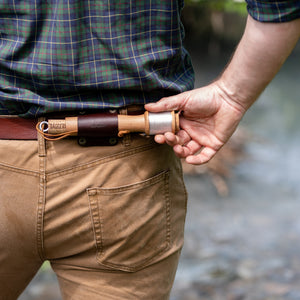Ultralight Backpacking vs. Bushcraft: Gear & Philosophies
If we were to lay out the ultralight backpacking and bushcraft communities on a venn diagram, there would be very little overlap between the two circles.
There are many reasons for that, but basically, the key difference is in their foundational philosophies: Ultralight backpacking is about going without. Bushcraft is about making due. In other words, ultralight backpacking teaches you how little you need to survive in the wilderness; bushcraft teaches you how much you can do with the little that you have.
Ultralight backpackers and bushcrafters are also on different quests. Ultralight backpackers are all about efficiency, movement, and time on-trail. DIADs (Done In a Day) and FKT (Fastest Known Time) are example quests for ultralighters, who push the bounds of what their bodies can do on the trail and how fast they can get it done.
Bushcrafters, on the other hand, tend to stay in one place, prioritizing “camp time” over “trail time.” They push their bodies, too, but more in the direction of hands-on skills and use of tools.
Their quests include obtaining what they need in the environment around them, perfecting the art of the campfire, constructing shelters, fishing, etc.

Ultralight Backpacking Gear vs. Bushcraft Gear
Basically, the difference in gear philosophies for backpacking and bushcraft is the difference between cold-soaking noodles and carrying an axe.

In ultralight backpacking, cold-soaking noodles lets you consume edible calories without a stove. Not the most pleasant, but it works if your goal is to consume enough calories to keep moving. It’s a very clever solution to that specific problem. In general, ultralight backpacking gear is ingenious at solving specific problems.
With bushcraft, there’s a greater focus on tools and how you can use those tools to do more for you. With an axe, you can chop firewood for a fire to cook dinner, and you can use it to forage, to make a shelter. An axe is exponentially heavier than noodles, of course, but cold noodles won’t keep you warm on a brisk night. So there’s tradeoffs.
(Daggerfish products, by design, fit somewhere in the middle of these two attitudes. The construction method for the Daggerfish Handreel removes so much material that it ends up weighing just a few ounces—a plus for ultralight backpackers who also want to combine an activity (fishing) with their backcountry experience.)
Common Ground Between Ultralight Backpacking and Bushcraft
It’s impossible to put everyone into a clearly defined subculture, but most people who are into outdoor adventuring agree that you don’t really need a lot.
Both ultralight and bushcraft have a minimalist approach to the outdoors, as well as what I would call a “growth mentality.” Both would agree that it’s valuable for human beings to test themselves out in the wilderness. And both would go further and say that, by using a minimum of technology, we can be relatively safe, comfortable, and healthier—even happier—with our engagement in nature.
Ultralight materials and construction have started to matriculate into general outdooring. Really, there’s no reason bushcrafters can’t take advantage of some of these materials to reduce weight.
As far as what they can learn from each other, backpackers—and to a certain extent bushcrafters—can benefit from the ultra-light question of “do I really need this?” The answer is often “no.” Humans have been living in nature for much of our existence, and while it’s rare that humans sleep in the woods alone, we’re animals and are capable of doing that without dying.
In our modern world, the actual dangers encountered by most people in the wilderness are minimal. Help is usually pretty close most of the time, and you can handle a little more discomfort than you think you can.
Who Has the Final Say in Outdoor Adventuring?
In the end, there is no ultimate authority on being outdoors. It’s just a cycle and every time we cycle into it, we do so with a new perspective.
We started off being inseparable from nature, then diverged and created civilizations that made us feel distinct, and we saw nature as something to conquer and exploit. Then we started to see it as something that needed to be respected and preserved.
Even the idea of “conserve” and “preserve” changes generation to generation. What it means to be good at being in the wilderness changes, too. We’re unable to see this from anywhere except our place in time.
But if we think about values and what feels good to us, and we use our time in nature to reflect on that, we can learn to do it better and better and better for ourselves, and hopefully with others, by helping them feel calm and confident out there.




















